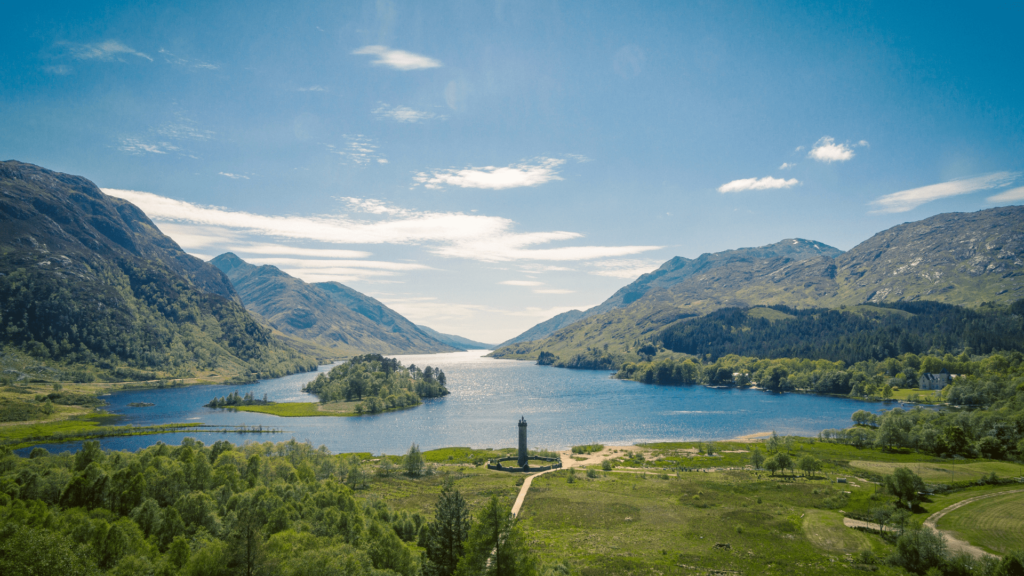Scotland is a country that offers beauty in every direction. Whether it is the sweeping moorlands, dramatic coastlines or the quiet charm of its villages, Scotland’s landscape invites you to pause, look more closely, and breathe a little more deeply. There is something uniquely grounding about its natural scenery and heritage, offering visitors a calm yet memorable experience.
Landscapes That Stay With You
One of Scotland’s most striking features is its variety of landscapes. The Highlands are perhaps the best known, with their wide glens, steep hills and deep lochs. Standing in Glencoe, surrounded by mountains and silence, it is easy to feel a deep sense of space and time. The area’s layered rock faces and soft, mossy ground have been shaped by both geological force and centuries of weather. Rain is common, but it only adds to the character of the place, bringing out the greens and greys in the hills and making the air feel fresh and clean.
Loch Lomond, Loch Tay and Loch Ness are among the most visited freshwater lakes, each with its own character. Loch Lomond, set within a national park, combines forested shorelines with distant views of Ben Lomond, one of the country’s more accessible peaks. In contrast, Loch Ness stretches long and narrow, its dark waters adding a touch of mystery that goes well beyond the legends.
The islands offer a different kind of beauty. The Isle of Skye, for example, is well known for its coastal cliffs, sea stacks and the distinctive rock formations of the Quiraing and the Old Man of Storr, which make for an iconic Scotland adventure. On a clear day, the views stretch across the sea to the Outer Hebrides. On a cloudy one, the landscape feels more introspective, full of mist and movement.
A Coastline That Tells Stories
Scotland’s coastline is just as compelling as its interior. With over 10,000 kilometres of coastline, it ranges from gentle sandy bays to harsh, rocky headlands. In places like the Moray Firth, you can see bottlenose dolphins from the shore. Elsewhere, on the beaches of Arisaig or the machair of the Hebrides, the sea meets wildflowers and dunes in quiet harmony.
Perhaps the most striking parts of the coast are those that still carry visible signs of human history. The ruins of castles sit on cliff edges, battered by wind and salt air. Dunnottar Castle, for instance, stands above the North Sea in Aberdeenshire, with waves crashing far below and seabirds wheeling overhead. These places feel timeless, their beauty rooted in their solitude and sense of endurance.
Villages and Cities in Harmony with Nature
While the landscapes are remarkable, the towns and cities offer their own charm, and are perfect for a Scotland retreat. Many are built with local stone, blending well with their surroundings. Edinburgh, with its dramatic skyline of castle, crags and spires, is a capital with both grandeur and intimacy. Walk up Arthur’s Seat, an extinct volcano in Holyrood Park, and you can see the city laid out beneath you, the sea in the distance and the Pentland Hills behind.
In the Highlands and Islands, villages like Plockton or Tobermory are brightly painted and surrounded by scenery that feels almost too picturesque to be real. These places may be small, but they are full of character, offering quiet streets, local food, and views that change with every shift in the weather.
The Presence of History
Much of Scotland’s beauty comes not only from the land itself, but from the stories it holds. Castles, standing stones, abbeys and battlefields are scattered across the country, often in places of great natural beauty. The combination of historical depth and striking location creates a sense of connection between past and present.
The standing stones of Callanish on the Isle of Lewis, older than Stonehenge, are set against open skies and distant hills. At Stirling or Bannockburn, the land remembers battles that shaped the nation. Even the roads, like the winding North Coast 500 or the single-track lanes of Sutherland, lead you through history as much as scenery.
A Natural, Unforced Beauty
What makes Scotland’s beauty stand out is how unforced it feels. It does not try to impress with bright colours or artificial grandeur. Instead, its charm lies in the quiet richness of detail: the way the light catches a loch at dusk, the texture of lichen on a stone wall, the call of a curlew over empty ground.
It is a place where you do not need to rush. Walking, driving or simply sitting with a view is enough. The weather may change quickly, but that only adds to the sense of being somewhere alive and real.
Scotland is beautiful not in a showy or dramatic way, but in a manner that rewards attention and reflection. It is a country shaped by time, weather and people, full of quiet places that stay with you long after you have gone. Whether you visit once or return many times, the experience is always different — and always worth it.
